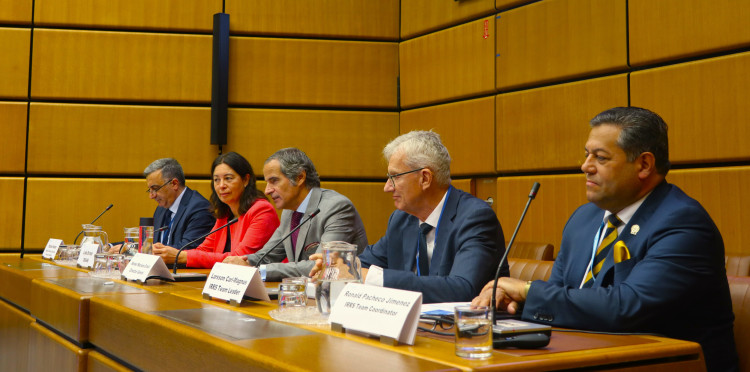The first-ever independent review of the International Atomic Energy Agency's (IAEA) internal radiation safety regulatory framework has confirmed that the system is well-established, with the IAEA's regulator showing a strong dedication to ongoing enhancement and improvement. The review provided recommendations for a further strengthening and enhancing of the Agency's regulatory system for safety.
The Integrated Regulatory Review Service (IRRS) mission, held from 30 September to 9 October, was requested by IAEA Director General Rafael Mariano Grossi last year. In line with his request, the mission covered all core regulatory areas of radiation safety, waste safety, emergency preparedness and response, transport, and the interface with nuclear security.
The IAEA uses radiation technologies and implements international safety standards in its own operations, overseen by an independent regulator who is also part of IAEA staff.
This regulator provides safety oversight of activities which involve radiation uses at the Agency’s laboratories in Vienna, Seibersdorf, and Monaco. Additionally, the regulator oversees the IAEA's involvement in activities conducted, organized, or contracted within its Member States.
"Radiation safety demands unwavering vigilance and preparedness," said Director General Grossi. "By initiating this unique IRRS mission, the IAEA is leading by example, applying the best safety practices also to our own work and openly communicating on any gaps. This is especially important today, as the number of new nuclear projects continues to grow worldwide.”
Using IAEA safety standards and international good practices, IRRS missions are designed to strengthen the effectiveness of the national legal and regulatory infrastructures while recognizing the responsibility of each country to ensure nuclear and radiation safety. It is the first time an IRRS was conducted in an organization that does not belong to one Member State, a fact that was recognized by the IRRS team as a good practice.
“The Agency has demonstrated a strong commitment to IAEA safety standards by proactively utilizing the peer review system, typically designed for Member States, to evaluate its own internal implementation of these standards,” said Carl-Magnus Larsson, IRRS Team Leader. “This approach goes beyond what is required, is unique, and serves as a replicable model for other organizations”.
During the ten-day mission, the IRRS team – comprised of 10 senior regulatory experts from Canada, Czech Republic, Brazil, Norway, Qatar, Slovenia, United Arab Emirates, United Kingdom, United States of America and Zimbabwe, two IAEA staff members and one observer from Austria – held discussions with Agency staff and observed regulatory inspections at the Agency’s Insect Pest Control Laboratory in its nuclear applications laboratories in Seibersdorf, Austria.
The IRRS team concluded that the IAEA's regulatory programme for radiation, transport, and waste safety is well-established, demonstrating its strong commitment to upholding international safety standards. Additionally, the IRRS team welcomed the regulator's dedication to continuously advancing and improving the IAEA regulatory system.
The review also included recommendations to help the Agency further strengthen the effectiveness of its regulatory framework and functions. These recommendations will be detailed in the final report, which is expected to be completed within the next three months.
The findings included the need for the IAEA to:
- Develop a comprehensive policy and strategy for safety, tailored to the IAEA’s specific strategic and operational activities.
- Initiate a review of resourcing to ensure that the Regulator has sufficient human and financial resources for sustainable discharge of its assigned responsibilities, including the resources needed to continuously improve the regulatory framework and to enhance the competence of the regulatory staff.
- Consider formalising arrangements to ensure continued regulatory independence.
- Consider assessing events occurring at the IAEA laboratories involving radiation technologies at the Agency Seat against the International Nuclear and Radiological Event Scale (INES) and report those events at Level 2 and above to Member States.
The Team provided specific recommendations for the IAEA Regulator, including:
- Completing the documentation for the regulatory management system.
- Arranging for independent assessments of the regulator’s leadership for safety and safety culture at planned intervals to improve the overall safety performance.
- Finalizing and formally adopting procedures for authorization taking into account a graded approach.
- Developing an inspection programme and plan in accordance with a graded approach.
- Formally adopting a process for establishing regulations and regulatory guides, including the frequency for reviewing the regulatory guides and a system to ensure that the development and implementation of regulations and guides is based on a graded approach.
IAEA Deputy Director General and Head of the Department of Nuclear Safety and Security Lydie Evrard said that at a time when several countries are setting up or strengthening their regulatory frameworks the IRRS mission to the IAEA is indicative of the Agency’s own commitment to the international safety standards. This mission also demonstrates that every regulatory body can benefit enormously from such a review regardless of their size and status.
“The recommendations from this mission will help us to continuously improve and we are committed to further strengthening and enhancing the Agency's regulatory framework for radiation safety,” said Deputy Director General Evrard.
IAEA safety standards
The IAEA safety standards provide a robust framework of fundamental principles, requirements and guidance to ensure safety. They reflect an international consensus and serve as a global reference for protecting people and the environment from the harmful effects of ionizing radiation.


